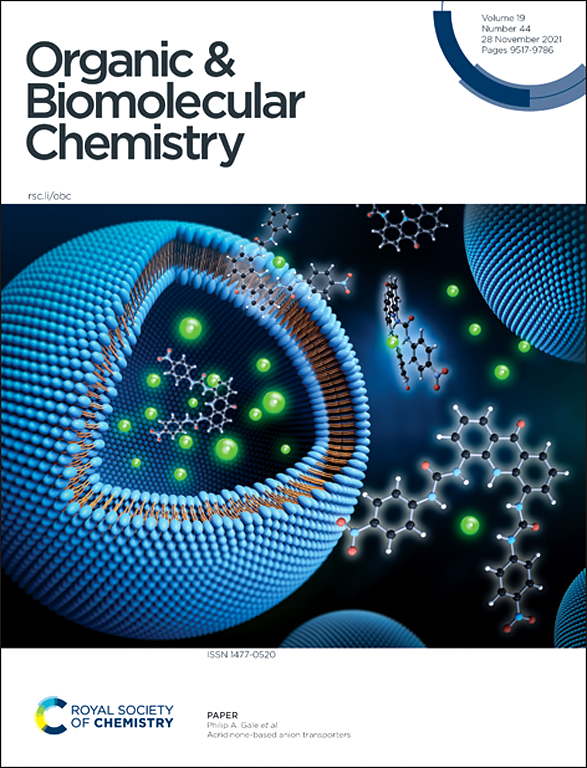Facile synthesis of functionalized quinolinones in a green reaction medium and their photophysical properties†
IF 2.7
3区 化学
Q1 CHEMISTRY, ORGANIC
引用次数: 0
Abstract
A facile and green chemical approach was successfully developed to construct functionalized quinolinones utilizing substituted alcohols, alkyl acetoacetate, and α-bromo ketones. Various quinolinones bearing either electron-rich or electron-deficient groups at different positions were synthesized in moderate to good yields under mild reaction conditions. The plausible mechanistic pathway for this transformation is supported by experimental evidence and control experiments. This simple approach for synthesizing quinolinones could open new avenues for discovering novel biological and pharmaceutical compounds. The use of affordable nickel catalysts, mild reaction conditions, operational simplicity, and high atom economy are attractive features of this method. Furthermore, the synthetic efficiency has been demonstrated through gram-scale experiments. Our research also provides valuable insights into the photophysical properties of the synthesized derivatives. Notably, compound exhibited the highest Stokes shift (216 nm) in DCM solvent. Furthermore, compounds and showed positive solvatochromism, displaying a stronger emission as the solvent polarity increased. Additionally, compound displayed aggregation-induced emission (AIE) properties in a DMSO : water mixture, making it suitable for use as a security ink, highlighting its potential applications in various fields.

在绿色反应介质中轻松合成功能化喹啉酮及其光物理特性。
利用取代醇、乙酰乙酸烷基酯和α-溴酮,成功开发了一种构建功能化喹啉酮的简便绿色化学方法。在温和的反应条件下,合成了各种在不同位置带有富电子或缺电子基团的喹啉酮,收率从中等到良好。实验证据和对照实验支持了这一转化的合理机理途径。这种合成喹啉酮的简单方法可为发现新型生物和药物化合物开辟新途径。使用价格低廉的镍催化剂、反应条件温和、操作简单和原子经济性高是这种方法的诱人之处。此外,该方法的合成效率已通过克级实验得到证实。我们的研究还为合成衍生物的光物理特性提供了宝贵的见解。值得注意的是,化合物 6n 在 DCM 溶剂中表现出最高的斯托克斯位移(216 nm)。此外,化合物 5d 和 6j 显示出正溶解色度,随着溶剂极性的增加,其发射更强。此外,化合物 6j 在二甲基亚砜:水的混合物中显示出聚集诱导发射(AIE)特性,使其适合用作防伪油墨,突出了其在各个领域的潜在应用。
本文章由计算机程序翻译,如有差异,请以英文原文为准。
求助全文
约1分钟内获得全文
求助全文
来源期刊

Organic & Biomolecular Chemistry
化学-有机化学
CiteScore
5.50
自引率
9.40%
发文量
1056
审稿时长
1.3 months
期刊介绍:
Organic & Biomolecular Chemistry is an international journal using integrated research in chemistry-organic chemistry. Founded in 2003 by the Royal Society of Chemistry, the journal is published in Semimonthly issues and has been indexed by SCIE, a leading international database. The journal focuses on the key research and cutting-edge progress in the field of chemistry-organic chemistry, publishes and reports the research results in this field in a timely manner, and is committed to becoming a window and platform for rapid academic exchanges among peers in this field. The journal's impact factor in 2023 is 2.9, and its CiteScore is 5.5.
 求助内容:
求助内容: 应助结果提醒方式:
应助结果提醒方式:


